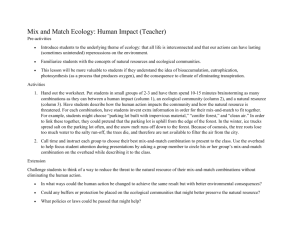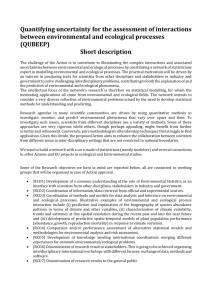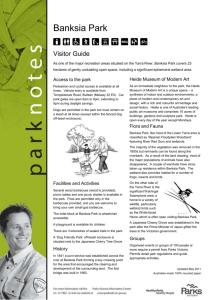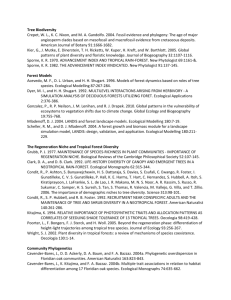Elderslie Banksia Scrub Forest of the Sydney Basin Bioregion: Draft
advertisement
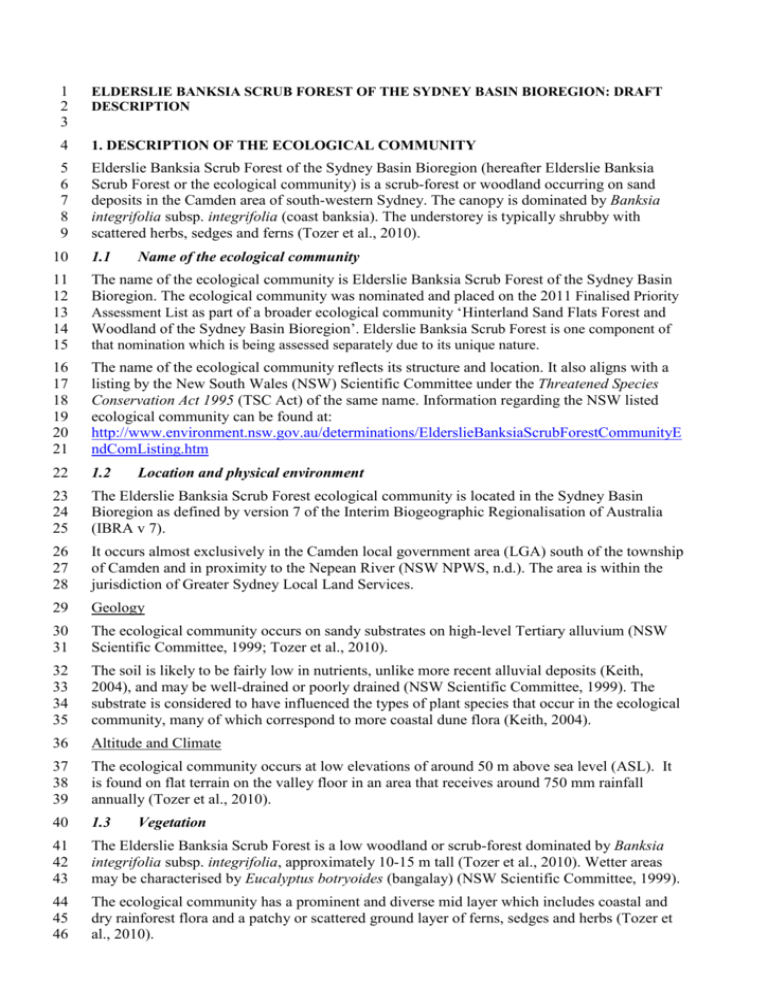
1 2 3 ELDERSLIE BANKSIA SCRUB FOREST OF THE SYDNEY BASIN BIOREGION: DRAFT DESCRIPTION 4 1. DESCRIPTION OF THE ECOLOGICAL COMMUNITY 5 6 7 8 9 Elderslie Banksia Scrub Forest of the Sydney Basin Bioregion (hereafter Elderslie Banksia Scrub Forest or the ecological community) is a scrub-forest or woodland occurring on sand deposits in the Camden area of south-western Sydney. The canopy is dominated by Banksia integrifolia subsp. integrifolia (coast banksia). The understorey is typically shrubby with scattered herbs, sedges and ferns (Tozer et al., 2010). 10 1.1 Name of the ecological community 11 12 13 14 15 The name of the ecological community is Elderslie Banksia Scrub Forest of the Sydney Basin Bioregion. The ecological community was nominated and placed on the 2011 Finalised Priority Assessment List as part of a broader ecological community ‘Hinterland Sand Flats Forest and Woodland of the Sydney Basin Bioregion’. Elderslie Banksia Scrub Forest is one component of that nomination which is being assessed separately due to its unique nature. 16 17 18 19 20 21 The name of the ecological community reflects its structure and location. It also aligns with a listing by the New South Wales (NSW) Scientific Committee under the Threatened Species Conservation Act 1995 (TSC Act) of the same name. Information regarding the NSW listed ecological community can be found at: http://www.environment.nsw.gov.au/determinations/ElderslieBanksiaScrubForestCommunityE ndComListing.htm 22 1.2 23 24 25 The Elderslie Banksia Scrub Forest ecological community is located in the Sydney Basin Bioregion as defined by version 7 of the Interim Biogeographic Regionalisation of Australia (IBRA v 7). 26 27 28 It occurs almost exclusively in the Camden local government area (LGA) south of the township of Camden and in proximity to the Nepean River (NSW NPWS, n.d.). The area is within the jurisdiction of Greater Sydney Local Land Services. 29 Geology 30 31 The ecological community occurs on sandy substrates on high-level Tertiary alluvium (NSW Scientific Committee, 1999; Tozer et al., 2010). 32 33 34 35 The soil is likely to be fairly low in nutrients, unlike more recent alluvial deposits (Keith, 2004), and may be well-drained or poorly drained (NSW Scientific Committee, 1999). The substrate is considered to have influenced the types of plant species that occur in the ecological community, many of which correspond to more coastal dune flora (Keith, 2004). 36 Altitude and Climate 37 38 39 The ecological community occurs at low elevations of around 50 m above sea level (ASL). It is found on flat terrain on the valley floor in an area that receives around 750 mm rainfall annually (Tozer et al., 2010). 40 1.3 41 42 43 The Elderslie Banksia Scrub Forest is a low woodland or scrub-forest dominated by Banksia integrifolia subsp. integrifolia, approximately 10-15 m tall (Tozer et al., 2010). Wetter areas may be characterised by Eucalyptus botryoides (bangalay) (NSW Scientific Committee, 1999). 44 45 46 The ecological community has a prominent and diverse mid layer which includes coastal and dry rainforest flora and a patchy or scattered ground layer of ferns, sedges and herbs (Tozer et al., 2010). Location and physical environment Vegetation 1 Canopy 2 3 4 5 The canopy is dominated by Banksia integrifolia subsp. integrifolia (coast banksia), or Eucalyptus botryoides (bangalay) in some wetter areas, and may contain Angophora subvelutina (rough-barked apple), E. baueriana (blue box) and/or Melaleuca decora (Tozer et al., 2010; NSW Scientific Committee, 2012). 6 Mid layer (low to medium shrubs) 7 8 9 10 11 12 13 14 Characteristic mid layer species include: Acacia decurrens (black wattle, green wattle, Sydney green wattle, Boo'kerrikin (D'harawal)), A. implexa (hickory wattle, weetjellan (D'harawal)), A. ulicifolia (prickly Moses), Aotus ericoides (common aotus), Brachyloma daphnoides (daphne heath), Breynia oblongifolia (coffee bush), Clerodendrum tomentosum (hairy clerodendrum), Dillwynia glaberrima (smooth-leaved dillwynia), Duboisia myoporoides (corkwood), Kunzea ambigua (tick bush), Persoonia linearis (narrow-leaved geebung), Pimelea linifolia subsp. linifolia (slender rice-flower), Platysace lanceolata (shrubby platysace) and Ricinocarpos pinifolius (wedding bush) (NSW Scientific Committee, 1999, 2012; Tozer et al., 2010). 15 Ground layer (ferns, sedges and herbs) 16 17 18 19 The ground layer often includes Dianella caerulea, Dianella revoluta, Gahnia clarkei (tall sawsedge), Hibbertia diffusa (wedge guinea flower), Gleichenia dicarpa (pouched coral fern, tangle fern), Lomandra spp. and Pteridium esculentum (common bracken) (NSW Scientific Committee, 1999, 2012; Tozer et al., 2010). 20 1.4 21 22 23 24 25 26 27 28 29 The following fauna have been recorded within the ecological community or similar native vegetation in the Camden LGA: Pygopus lepidopodus (common scaly-foot), Pogona barbata (bearded dragon), Ctenotus robustus (striped skink), Lampropholis guichenoti (garden skink), Pseudechis porphyriacus (red-bellied black snake), Tachyglossus aculeatus (short-beaked echidna), Petaurus breviceps (sugar glider), Trichosurus vulpecula (common brushtail possum), Pseudocheirus peregrines (common ringtail possum), Pteropus poliocephalus (greyheaded flying-fox), Rattus fuscipes (bush rat), Limnodynastes dumerilii (eastern banjo frog), L. peronii (brown-striped frog), L. tasmaniensis (spotted marsh frog), Litoria verreauxii (Verreaux's tree frog) and Crinia signifera (common eastern froglet) (Jones et al., 1997). 30 31 32 33 34 35 36 37 Avifauna recorded within or in proximity to the ecological include Acanthiza pusilla (brown thornbill), Artamus cyanopterus (dusky woodswallow), Colluricincla harmonica (grey shrikethrush), Malurus cyaneus (superb fairy-wren), M. lamberti (variegated fairy-wren), Pachycephala pectoralis (golden whistler), Eopsaltria australis (eastern yellow robin), Petroica rosea (rose robin), Lichenostomus chrysops (yellow-faced honeyeater), Ninox novaeseelandiae (southern boobook owl), Melanodryas cucullata (hooded robin), Pardalotus striatus and P. punctatus (striated and spotted pardalote), Rhipidura albiscapa (grey fantail), Sericornis frontalis (white-browed scrubwren) (Jones et al., 1997). 38 39 The nationally threatened Lathamus discolor (swift parrot) is a migratory species that may utilise the area over winter (Jones et al., 1997). 40 41 A number of threatened fauna are known to occur in or adjacent to the ecological community (NSW Scientific Committee, 2014), these are listed at Table 1. 42 Table 1. Threatened fauna found in or near Elderslie Banksia Scrub Forest Fauna Scientific name Chalinolobus dwyeri Lathamus discolor Meridolum corneovirens Common name large-eared pied bat swift parrot Cumberland land snail EPBC Act v e - TSC Act v e e Miniopterus schreibersii oceanensis Mormopterus norfolkensis Pteropus poliocephalus Scoteanax rueppellii eastern bentwing bat eastern free-tail bat grey-headed flying fox greater broad-nosed bat v - v v v v 1 2 1.5 Key diagnostic characteristics and condition thresholds 3 4 5 6 7 8 9 10 National listing focuses legal protection on remaining patches of the ecological community that are most functional, relatively natural (as described by the ‘Description’) and in relatively good condition. Key diagnostic characteristics and condition thresholds assist in identifying a patch of the threatened ecological community, determine when the Environment Protection and Biodiversity Conservation Act 1999 (EPBC Act) is likely to apply to the ecological community and to distinguish between patches of different quality. The ecological community may exhibit various degrees of disturbance and degradation. This degree of degradation has been taken into account in developing the condition thresholds. 11 1.5.1 Key diagnostic characteristics 12 13 14 15 The key diagnostic characteristics presented here summarise the main features of the ecological community. These are intended to aid the identification of the ecological community, noting that a broader description is given in the other sections. Key diagnostic characteristics for describing the Elderslie Banksia Scrub Forest ecological community are that it: 16 17 18 19 20 21 22 23 24 25 1.5.2 Condition thresholds 26 27 28 29 30 31 Condition classes and thresholds provide guidance for when a patch of a threatened ecological community retains sufficient conservation values to be considered as a Matter of National Environmental Significance, as defined under the EPBC Act. This means that the referral, assessment and compliance provisions of the EPBC Act are focussed on the most valuable elements of the ecological community. Very degraded patches that do not meet the condition thresholds will be largely excluded from national protection. 32 33 34 35 36 37 38 39 Although very degraded/modified patches are not protected as the ecological community listed under the EPBC Act, it is recognised that patches that do not meet the condition thresholds may still retain important natural values and may be protected through State and local laws or schemes. Therefore, these patches should not be excluded from recovery and other management actions. Suitable recovery and management actions may improve these patches to the point that they may be regarded as part of the ecological community fully protected under the EPBC Act. Management actions should, where feasible, also aim to restore patches to meet the high quality condition thresholds outlined below. 40 41 42 < Note: exact vegetative cover and patch size figures are to be finalised through further data analysis and consultation.> Occurs solely within the Sydney Basin Bioregion. Occurs on typically flat terrain near the Nepean River. Occurs at low altitude around 50 m ASL Occurs typically on sandy soil, on deposits of tertiary alluvium The vegetation structure is typically low woodland (also described as scrub and scrub/forest), less than 15 m tall with a prominent mid shrub layer. The canopy is usually dominated by Banksia integrifolia subsp. integrifolia, but Eucalyptus botryoides may dominate in the wettest areas. Other typical canopy species may include: Angophora subvelutina, Eucalyptus baueriana and Melaleuca decora. 1 2 3 4 5 For Elderslie Banksia Scrub Forest, categories A1 and A2 are considered the minimum thresholds for a patch of Elderslie Banksia Scrub Forest to be regarded as an example of high quality condition. Categories B1 and B2 are considered moderate quality condition and the minimum thresholds for a patch of the ecological community to be subject to the referral, assessment and compliance provisions of the EPBC Act. 6 Category and Rationale A1. High condition class Represented by medium to large size patch with very high quality native understorey A2. High condition class Represented by large size patch with high quality native understorey B1. Moderate condition class Represented by medium to large-size patch as part of a larger native vegetation remnant and/or with mature trees B2. Moderate condition class Represented by medium to large size patch with high quality native understorey Thresholds Patch size >0.5ha And >70% of the perennial understorey vegetation cover is made up of native species. Patch size >1ha And >50% of the perennial understorey vegetation cover is made up of native species. Patch size >0.5ha And >30% of the perennial understorey vegetation cover is made up of native species And The patch is contiguous with a native vegetation remnant (any native vegetation where cover in each layer present is dominated by native species) >1ha in area. Patch size >0.5ha And >50% of the perennial understorey vegetation cover is made up of native species. Perennial understorey vegetation cover includes vascular plant species of the ground and low to medium shrub layers with a lifecycle of more than two growing seasons. Measurements of perennial understorey vegetation cover exclude annuals, cryptogams, leaf litter or exposed soil. Contiguous means the patch of the ecological community is continuous with, or in close proximity (within 100 m), of another patch of vegetation that is dominated by native species in each vegetation layer present. 7 8 1.6 Defining a patch 9 10 11 12 13 14 A patch is defined as a discrete and continuous or semi-continuous area of the ecological community. A patch may include small-scale disturbances, such as tracks or breaks, watercourses or small-scale variations in vegetation that do not significantly alter its overall functionality (functionality here refers to processes such as the movement of wildlife and pollinators, the dispersal of plant propagules, activities of seed and plant predators and many others). 15 1.7 16 17 18 19 20 Areas that meet the condition thresholds are considered critical to the survival of Elderslie Banksia Scrub Forest. Additional areas, such as adjoining native vegetation and areas that meet the description of the ecological community but not the condition thresholds are also considered important to the survival of the ecological community. It is also important to consider the surrounding environment and landscape context. 21 1.8 22 23 Since European settlement, it is estimated the ecological community has undergone a reduction in extent of over 85%. Total remaining extent is 13 to15 ha. Area critical to the survival of the ecological community Geographic extent and patch-size distribution 1 2 Average patch size and the largest patch size are both less than 10 ha (NSW Scientific Committee and Simpson, 2008, based on Tozer et al., 2003). 3 1.9 4 NSW Threatened Species Conservation Act 1995: 5 6 7 8 NSW state listed ecological communities do not include condition thresholds. Relationships to State-listed ecological communities Elderslie Banksia Scrub Forest in the Sydney Basin Bioregion – endangered (a draft determination is currently on public exhibition regarding potential up-listing to critically endangered). 9 10 The ecological community corresponds, entirely or in part, to the following vegetation classifications: 11 12 13 14 The ecological community forms part of the Sydney Sand Flats Dry Sclerophyll Forest described by Keith (2004). 15 1.10 16 17 18 The following vegetation types occur in western south-west Sydney on sandy substrates. They can generally be differentiated from Elderslie Banksia Scrub Forest by their location in the landscape and floristic composition. 19 1.10.1 Similar communities 20 Agnes Banks Woodland (DSF p239, Tozer et al., 2010) 21 22 23 24 25 26 Agnes Banks Woodland occurs on a similar substrate to Elderslie Banksia Scrub, and has similar coastal floral characteristics. It primarily occurs on deep Aeolian (wind-blown) sands, overlying Tertiary alluvium. It occurs further north than Elderslie Banksia Scrub Forest, around the Agnes Banks township, and at a slightly higher elevation of around 70 m ASL. Both ecological communities contain Banksia integrifolia subsp. integrifolia and Melaleuca decora, but they differ in many of the other characteristic canopy and understorey flora. 27 Cumberland River Flat Forest (FoW p33, Tozer et al., 2010) 28 29 30 31 32 Cumberland River Flat Forest is a woodland or open forest occurring on alluvial flats and stream-banks in the Hawkesbury-Nepean and Georges River regions. It differs to Elderslie Banksia Scrub Forest in that its canopy is not dominated by Banksia integrifolia subsp. integrifolia, and its typically open shrub layer with a continuous ground cover of grasses and forbs (Tozer et al., 2010). 33 1.10.2 Intergrading communities 34 35 36 The ecological community is adjacent to and intergrades with the nationally listed Cumberland Plain Shale Woodlands and Shale-Gravel Transition Forest and river flat forest communities (NSW Scientific Committee, 1999). Tozer et al. (2010) - DSF p463 Elderslie Banksia Scrub Forest. Differences to similar or intergrading ecological communities 1 Bibliography 2 3 4 5 Jones, H., Recsei, J., Delaney, R., Barker, C., Williams, S. & Chessman, B. (1997). Native fauna of Western Sydney - Urban bushland biodiversity survey. NSW National Parks and Wildlife Service, Hurstville. 6 7 Keith, D.A. (2004). Ocean shores to desert dunes: the native vegetation of New South Wales and the ACT. NSW Department of Environment and Conservation, Sydney. 8 9 10 11 12 NSW National Parks & Wildlife Service (NSW NPWS) (n.d.). NSW National Parks & Wildlife Service − 1:25 000 Map Series − Map 5 of 16 [Mapping project undertaken 1997-2000]. Available on the internet at http://www.environment.nsw.gov.au/resources/nature/vegmapCumberlandPlain05Camde n.pdf 13 14 15 16 NSW Scientific Committee (1999). Elderslie banksia scrub forest community - endangered ecological community listing: Final determination. Available on the internet at: http://www.environment.nsw.gov.au/determinations/ElderslieBanksiaScrubForestCommu nityEndComListing.htm 17 18 19 NSW Scientific Committee (2012). Elderslie Banksia Scrub Forest – profile. Available on the internet at: http://www.environment.nsw.gov.au/threatenedSpeciesApp/profile.aspx?id=10263 20 21 22 23 NSW Scientific Committee (2014). Preliminary determination [Elderslie banksia scrub forest]. Available on the internet at: http://www.environment.nsw.gov.au/resources/threatenedspecies/determinations/PDElder slie%20BanksiaScrubCEEC.pdf 24 25 26 NSW Scientific Committee and Simpson, C.C. (2008). Change in the distribution of Cumberland Plain Woodland - cumberland_V2_2008_VISmap_3785, 1:100,000 [an update to Tozer et al., 2003 vegetation classifications]. NSW DECC. 27 28 29 30 Tozer, M.G., Turner, K., Keith, D.A., Tindall, D., Pennay, C., Simpson, C., MacKenzie, B., Beukers, P. & Cox, S. (2010). Native vegetation of southeast NSW: a revised classification and map for the coast and eastern tablelands. Cunninghamia 11(3), 359406. 31 32



